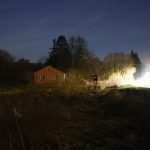A powerful earthquake and tsunami struck central Japan and its western coast on Monday, triggering warnings for residents to evacuate, knocking out power to thousands of homes and disrupting flights and rail services to the affected region.
The quake with a preliminary magnitude of 7.6 triggered waves of around 1 meter along parts of the Sea of Japan coast with a larger wave expected, public broadcaster NHK reported.
The Japan Meteorological Agency has issued tsunami warnings for the coastal prefectures of Ishikawa, Niigata and Toyama. Russia also issued tsunami warnings in its far eastern cities of Vladivostok and Nakhodka.
Authorities are still assessing the extent of the damage and residents need to prepare for any more tremors, Prime Minister Fumio Kishida said in comments aired on NHK.
“Residents need to stay on alert for further possible quakes and I urge people in areas where tsunamis are expected to evacuate as soon as possible,” Kishida said.
Footage aired by NHK showed a building collapsing in a plume of dust in the coastal city of Suzu and residents in Kanazawa city cowering under tables as tremors shook their home. The quake also jolted buildings in the capital Tokyo on the opposite coast.
More than 36,000 households had lost power in Ishikawa and Toyama prefectures, utilities provider Hokuriku Electric Power said.
High speed rail services to Ishikawa have been suspended while telecom operators Softbank and KDDI reported phone and internet service disruptions in Ishikawa and Niigata, according to their websites.
Japanese airline ANA turned back four planes headed to airports in Toyama and Ishikawa midair after the quake, while Japan Airlines cancelled most of the flight services to Niigata and Ishikawa regions for the rest of the day, according to TV Asahi.
Japan’s Nuclear Regulation Authority said no irregularities have been confirmed at nuclear power plants along the Sea of Japan, including five active reactors at Kansai Electric Power‘s Ohi and Takahama plants in Fukui Prefecture.
Hokuriku’s Shika plant in Ishikawa, which was located the closest to the quake’s epicenter, had already halted its two reactors before the quake for regular inspection and saw no impact from the quake, the agency said.
A huge earthquake and tsunami struck northeastern Japan on March 11, 2011, killing nearly 20,000 people, devastating towns and triggering nuclear meltdowns in Fukushima.
Read the full article here




